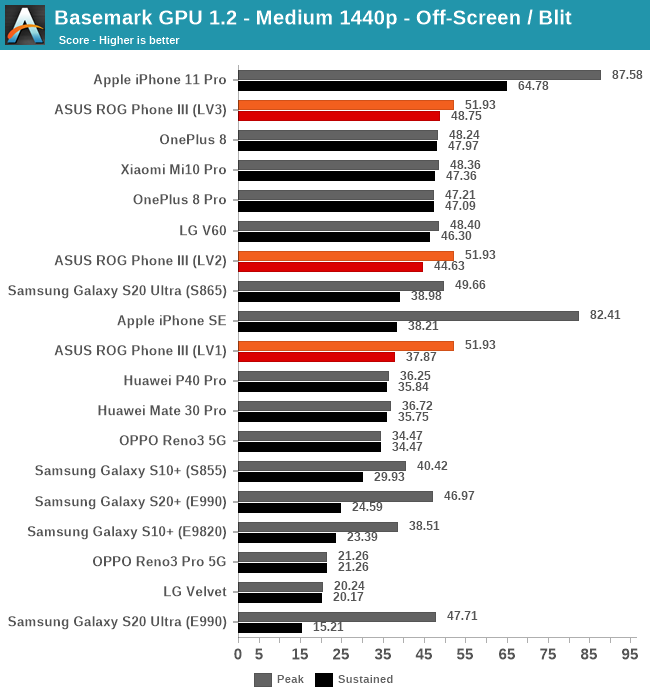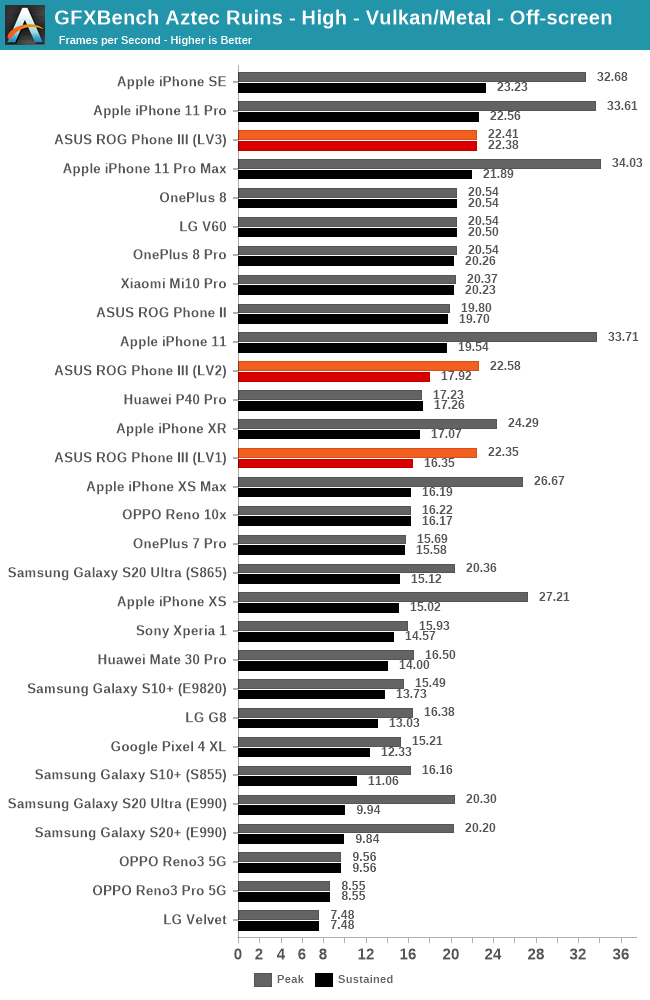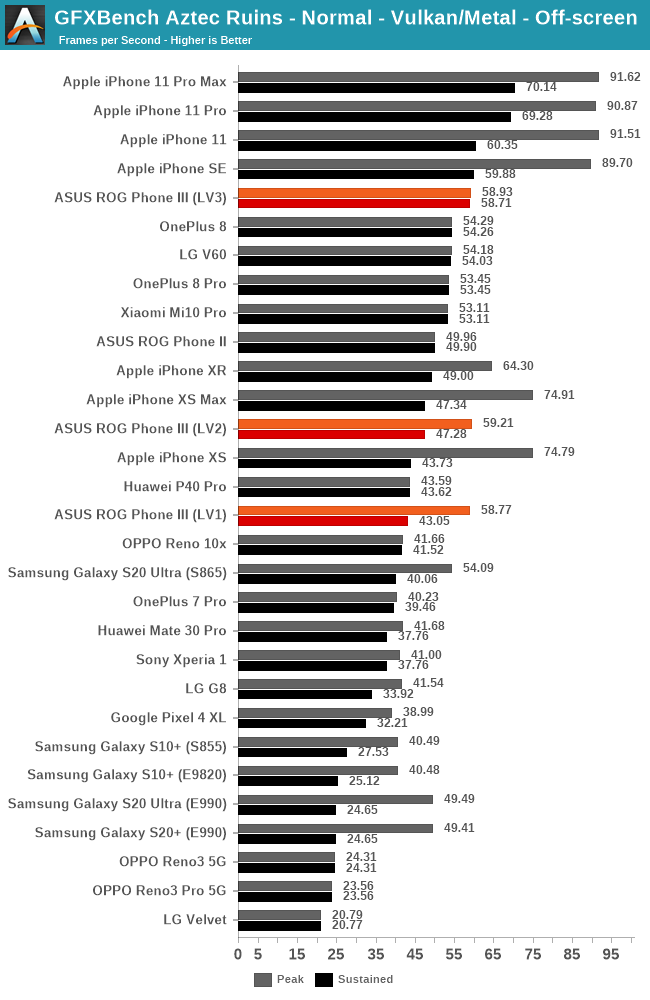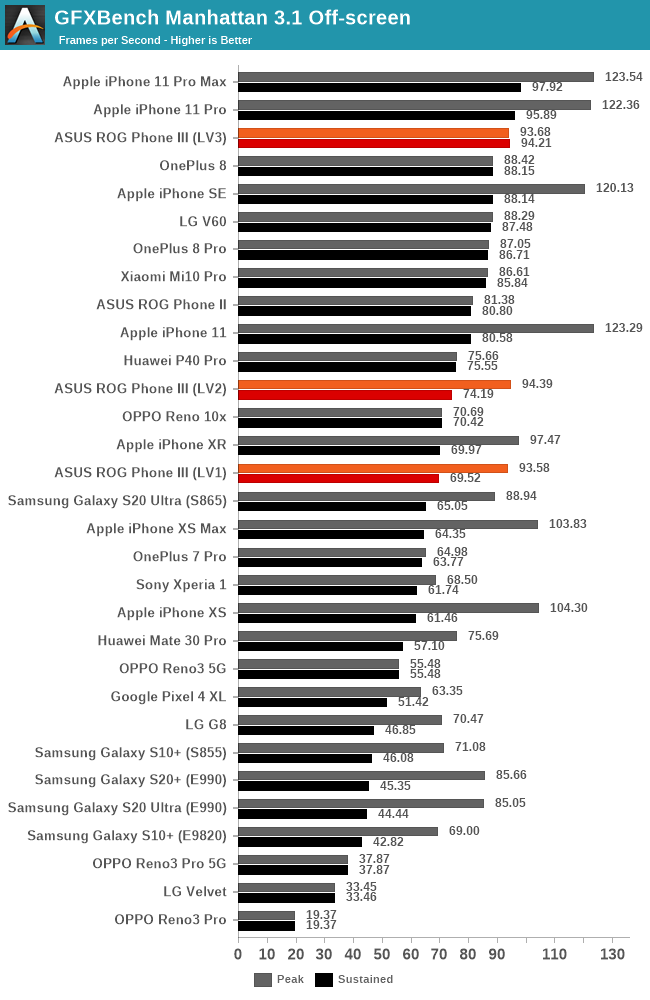The ASUS ROG Phone III Review: A 144Hz 6000mAh Beast With Caveats
by Andrei Frumusanu on August 28, 2020 9:00 AM EST- Posted in
- Mobile
- Smartphones
- Snapdragon 865
- ROG Phone III
GPU Performance & Power
GPU performance of the ROG Phone III should be its very strong-point, as that’s the primary selling point of the device. The new Snapdragon 865+ promises 10% better performance than the regular Snapdragon 865, and we’ve seen quite a few excellently performing S865 devices over the last few months.
How will the ROG3 be able to distinguish itself from the crowd with its fancy cooling solutions, given that the crowd already performs that well?

Starting off with Basemark GPU 1.2, we’re off to some odd results.
In the default mode (LV1), the phone’s peak performance is right about where expect it to be, roughly 10% faster than Snapdragon 865 devices in the market. What’s rather disappointing is the phone’s sustained performance figures which are significantly worse than other phones in the market.
I noted that the phone didn’t really get hot at all in its default operating mode, with peak skin temperature not exceeding 37°C which is very conservative. I decided to also test the gaming performance in its X-Modes;
At LV2, the phone gets notably hotter and is allowed to reach up to around 45°C peak skin temperatures, with sustained performance getting a nice boost. However, versus the competition, these results are still a tad disappointing as it still lags behind LG, Xiaomi and OnePlus phones, all of which are actually cooler.
Finally, in LV3 mode with the AeroCooler connected, the phone gets a slight sustained performance boost, finally taking the top place amongst Android devices, albeit with only a sliver of a margin.

GFXBench Aztec High showcases a similar performance raking, with the default mode ROG3 performing very conservatively, requiring the AeroCooler to be able to keep up with other phones in the market.
| GFXBench Aztec High Offscreen Power Efficiency (System Active Power) |
||||
| Mfc. Process | FPS | Avg. Power (W) |
Perf/W Efficiency |
|
| iPhone 11 Pro (A13) Warm | N7P | 26.14 | 3.83 | 6.82 fps/W |
| iPhone 11 Pro (A13) Cold / Peak | N7P | 34.00 | 6.21 | 5.47 fps/W |
| Galaxy S20 Ultra (Snapdragon 865) | N7P | 20.35 | 3.91 | 5.19 fps/W |
| iPhone XS (A12) Warm | N7 | 19.32 | 3.81 | 5.07 fps/W |
| Reno3 5G (Dimensity 1000L) | N7 | 11.93 | 2.39 | 4.99 fps/W |
| iPhone XS (A12) Cold / Peak | N7 | 26.59 | 5.56 | 4.78 fps/W |
| ROG Phone III (Snapdragon 865+) | N7P | 22.34 | 5.35 | 4.17 fps/W |
| Mate 30 Pro (Kirin 990 4G) | N7 | 16.50 | 3.96 | 4.16 fps/W |
| Galaxy S20+ (Exynos 990) | 7LPP | 20.20 | 5.02 | 3.59 fps/W |
| Galaxy S10+ (Snapdragon 855) | N7 | 16.17 | 4.69 | 3.44 fps/W |
| Galaxy S10+ (Exynos 9820) | 8LPP | 15.59 | 4.80 | 3.24 fps/W |
GFXBench Aztec High showcases a similar performance raking, with the default mode ROG3 performing very conservatively, requiring the AeroCooler to be able to keep up with other phones in the market.
It was very odd to see the ROG3 perform quite this poorly, and most importantly getting that much hotter than the competition. I re-measured the power consumption of the device and the Snapdragon 865+ only to note that the new SoC is seemingly using quite a lot more power than the standard Snapdragon 865, reaching up to 5.35W versus 3.91W on the Galaxy S20 Ultra.

| GFXBench Aztec Normal Offscreen Power Efficiency (System Active Power) |
||||
| Mfc. Process | FPS | Avg. Power (W) |
Perf/W Efficiency |
|
| iPhone 11 Pro (A13) Warm | N7P | 73.27 | 4.07 | 18.00 fps/W |
| iPhone 11 Pro (A13) Cold / Peak | N7P | 91.62 | 6.08 | 15.06 fps/W |
| iPhone XS (A12) Warm | N7 | 55.70 | 3.88 | 14.35 fps/W |
| Galaxy S20 Ultra (Snapdragon 865) | N7P | 54.09 | 3.91 | 13.75 fps/W |
| iPhone XS (A12) Cold / Peak | N7 | 76.00 | 5.59 | 13.59 fps/W |
| Reno3 5G (Dimensity 1000L) | N7 | 27.84 | 2.12 | 13.13 fps/W |
| ROG Phone III (Snapdragon 865+) | N7P | 58.77 | 5.34 | 11.00 fps/W |
| Mate 30 Pro (Kirin 990 4G) | N7 | 41.68 | 4.01 | 10.39 fps/W |
| Galaxy S20+ (Exynos 990) | 7LPP | 49.41 | 4.87 | 10.14 fps/W |
| Galaxy S10+ (Snapdragon 855) | N7 | 40.63 | 4.14 | 9.81 fps/W |
| Galaxy S10+ (Exynos 9820) | 8LPP | 40.18 | 4.62 | 8.69 fps/W |
Aztec normal showcases the same results and power draw characteristics.

| GFXBench Manhattan 3.1 Offscreen Power Efficiency (System Active Power) |
||||
| Mfc. Process | FPS | Avg. Power (W) |
Perf/W Efficiency |
|
| iPhone 11 Pro (A13) Warm | N7P | 100.58 | 4.21 | 23.89 fps/W |
| Galaxy S20 Ultra (Snapdragon 865) | N7P | 88.93 | 4.20 | 21.15 fps/W |
| iPhone 11 Pro (A13) Cold / Peak | N7P | 123.54 | 6.04 | 20.45 fps/W |
| iPhone XS (A12) Warm | N7 | 76.51 | 3.79 | 20.18 fps/W |
| Reno3 5G (Dimensity 1000L) | N7 | 55.48 | 2.98 | 18.61 fps/W |
| iPhone XS (A12) Cold / Peak | N7 | 103.83 | 5.98 | 17.36 fps/W |
| ROG Phone III (Snapdragon 865+) | N7P | 93.58 | 5.56 | 16.82 fps/W |
| Mate 30 Pro (Kirin 990 4G) | N7 | 75.69 | 5.04 | 15.01 fps/W |
| Galaxy S20+ (Exynos 990) | 7LPP | 85.66 | 5.90 | 14.51 fps/W |
| Galaxy S10+ (Snapdragon 855) | N7 | 70.67 | 4.88 | 14.46 fps/W |
| Galaxy S10+ (Exynos 9820) | 8LPP | 68.87 | 5.10 | 13.48 fps/W |
| Galaxy S9+ (Snapdragon 845) | 10LPP | 61.16 | 5.01 | 11.99 fps/W |
| Mate 20 Pro (Kirin 980) | N7 | 54.54 | 4.57 | 11.93 fps/W |
| Galaxy S9 (Exynos 9810) | 10LPP | 46.04 | 4.08 | 11.28 fps/W |
| Galaxy S8 (Snapdragon 835) | 10LPE | 38.90 | 3.79 | 10.26 fps/W |
| Galaxy S8 (Exynos 8895) | 10LPE | 42.49 | 7.35 | 5.78 fps/W |
Manhattan 3.1 is the same as well; here the power consumption grows to up to 5.56W which is extremely high and well beyond that a smartphone can normally dissipate.

| GFXBench T-Rex Offscreen Power Efficiency (System Active Power) |
||||
| Mfc. Process | FPS | Avg. Power (W) |
Perf/W Efficiency |
|
| iPhone 11 Pro (A13) Warm | N7P | 289.03 | 4.78 | 60.46 fps/W |
| iPhone 11 Pro (A13) Cold / Peak | N7P | 328.90 | 5.93 | 55.46 fps/W |
| Galaxy S20 Ultra (Snapdragon 865) | N7P | 205.37 | 3.83 | 53.30 fps/W |
| iPhone XS (A12) Warm | N7 | 197.80 | 3.95 | 50.07 fps/W |
| ROG Phone III (Snapdragon 865+) | N7P | 224.48 | 4.92 | 45.60 fps/W |
| iPhone XS (A12) Cold / Peak | N7 | 271.86 | 6.10 | 44.56 fps/W |
| Galaxy 10+ (Snapdragon 855) | N7 | 167.16 | 4.10 | 40.70 fps/W |
| Reno3 5G (Dimensity 1000L) | N7 | 139.30 | 3.57 | 39.01 fps/W |
| Galaxy S20+ (Exynos 990) | 7LPP | 199.61 | 5.63 | 35.45 fps/W |
| Mate 30 Pro (Kirin 990 4G) | N7 | 152.27 | 4.34 | 35.08 fps/W |
| Galaxy S9+ (Snapdragon 845) | 10LPP | 150.40 | 4.42 | 34.00 fps/W |
| Galaxy 10+ (Exynos 9820) | 8LPP | 166.00 | 4.96 | 33.40fps/W |
| Galaxy S9 (Exynos 9810) | 10LPP | 141.91 | 4.34 | 32.67 fps/W |
| Galaxy S8 (Snapdragon 835) | 10LPE | 108.20 | 3.45 | 31.31 fps/W |
| Mate 20 Pro (Kirin 980) | N7 | 135.75 | 4.64 | 29.25 fps/W |
| Galaxy S8 (Exynos 8895) | 10LPE | 121.00 | 5.86 | 20.65 fps/W |
T-Rex also shows a big increase in power consumption, over 1W worse than the Snapdragon 865.
Power-hungry Snapdragon 865+?
Overall, the ROG Phone III’s disappointing thermals and rather odd and worse sustained performance figures seem to be explained by the new SoC’s vastly increased power consumption characteristics. I made sure that this wasn’t just a measurement fluke, both in regards to power and the sustained performance figures and went ahead and retested a past phone such as the Mi 10 Pro, and I got the very same results. The regular non-gaming Snapdragon 865 phone was just cooler than the ROG Phone III, and was able to maintain higher performance over prolonged periods of time than the ASUS device.
Yes, the AeroCooler does help with the dissipation of heat, but in absolute terms, that’s a quite high price to pay in order to get a tiny advantage over other devices which don’t require any extra cooling.










71 Comments
View All Comments
Kishoreshack - Friday, August 28, 2020 - link
Just love how far ASUS has come with its phonesKangal - Sunday, August 30, 2020 - link
Yeah, in 2019... but this year they have gotten worse.Just compare the Zenfone 6 to the Zenfone 7 for starters.
On the ROG 2 vs ROG 3,
The new device is slightly larger, heavier, and lost the 3.5mm Jack. And it raised the prices.
But comparing the 16GB RAM vs 12GB RAM, isn't that big deal. And the uplift from the QSD 855 to the 865/865+ is hardly impressive. Or the 5900mAh battery compared to the 6,000mAh battery. Even the screen is the same comparing 144Hz to 120Hz, or the 270Hz-Touch to the 240Hz-Touch. By most metrics the new model is the same or worse than the older one.
And again, it's more expensive. I think that second chipset (Qualcomm's external modem) is the culprit for this year's lacklustre phones (larger, hotter, battery thirstier, less internal space, more expensive).
The only point where ASUS has made a notable upgrade is in the camera. And that's on both the ROG 3 and the Zenfone 7. But it's hardly a reason for someone to choose to buy a new ROG3, when they could get the ROG2 on a discount.
I think I could've been fine with the ASUS ROG 3, if they kept the 3.5mm headphone jack, added a microSD slot, and added wireless charging. That would've made the +$200 price hike easier to swallow. If they included JoyCons in the box, it would've been an instant hit.
To be honest, I would've preferred they downsized it slightly to around (166 x 74 x 9mm) which is like the size of the OnePlus 8 Pro, any larger makes it unpocketable for most regular mens jeans/pants. Even if that means downsizing the 6000mAh battery down to 5000mAh battery, it's worth it for the quality of life improvement.
s.yu - Monday, August 31, 2020 - link
When SD865 prices just got announced people were seeing a price hike of the handsets as inevitable. This phone looks decidedly less "gaming" than the predecessor and that's a big plus for me, and the second C port means the lack of the jack is at least tolerable. How they should cut corners on the optics so much confuses me, I'm wondering if this is a defective unit.There's rumor that Samsung is still contemplating bringing back the jack in flagships next year so I'm taking the wait and see approach, the S-Pen for me is worth it, but if Samsung doesn't follow through then I'll come back and buy one of these second-handed. With far superior battery to the Sony, it's already the closest thing to an all-rounder on the market.
Kangal - Monday, August 31, 2020 - link
I'm thinking the next year's QSD 875 will be like 8% faster simply because of the 5nm advancement. Plus another 8% speed due to slight architectural improvement in the X1 core, and modem efficiency.Yes most important, it should have the 4G/5G modem integrated (hopefully)... and that should mean better efficiency, and slightly larger internal space. So we could see the 3.5mm Headphone Jack make a comeback because of that.
But Samsung has killed the Jack for good. They have their own wireless earphones for sale. They got rid of it on the Note10 for no good reason. It's not coming back. Heck, even if they wrongly accuse the internal space restrictions, which is not true, there is no reason that they cannot integrate the 3.5mm Headphone Jack into the underside of the SPen.
I'm hoping this year has negatively affected all OEMs that they re-introduce some wanted features next year like Headphone Jack, microSD... on top of REDUCING the prices down (-30% ?) to regular levels to ensure strong sales/continued sales. I think this year proved that marketing wasn't strong enough to deceive the consumers.
s.yu - Wednesday, September 2, 2020 - link
lol I would bet on a comeback of the 3.5mm than a 30% price drop. Anyhow, the market hasn't exactly been exciting this year so I'm truly not in a hurry to upgrade, so I'll wait and see until there's something solid suggesting no jack again.flyingpants265 - Tuesday, September 1, 2020 - link
Joycons are stupid, it should be a whole PSP-like controller case that locks in place, to literally turn your phone into a PSP. Then we can have serious game development and ports for phones.This should have been available since 2007 or before. 13 years later and we're still using weird flimsy attachable joycon things.
The current Chinese Bluetooth psp-style controllers suck bad.
Kishoreshack - Friday, August 28, 2020 - link
The most awaited review is finally hereWanted to see how it fares against other flagships
Kishoreshack - Friday, August 28, 2020 - link
6000 mah battery with 865 plus & 144hz display is an instant sell for menico_mach - Friday, August 28, 2020 - link
Yes, this, I think this phone is more compelling outside of its gaming. Esp in comparison to iphones - they dominate the performance but usually ship with tiny batteries. Android phones need to carve out a niche, and this phone does that.melgross - Monday, August 31, 2020 - link
They still have some if the best battery life. And they’re not “tiny” batteries. iOS doesn’t need very large batteries as Androud phones do.